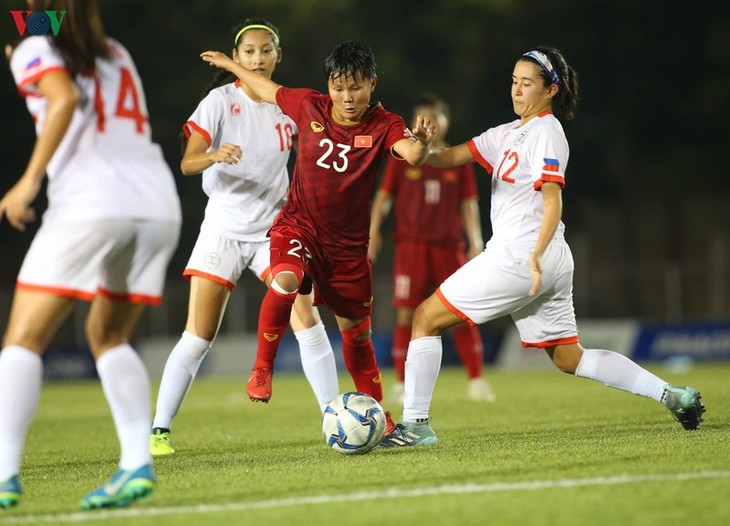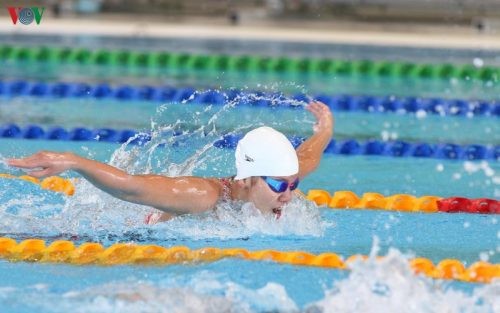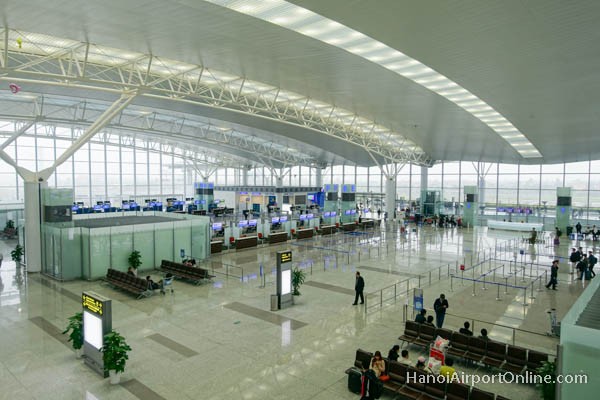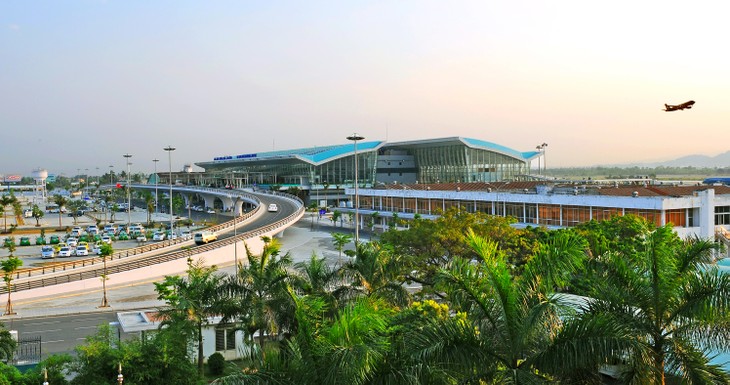B: Nusrat Zahan of the VOV5 Listeners’ Zone in Bangladesh said our Saturday report was informative. He knew about Vietnam’s aim to finish in the top three at SEA Games 30. Congratulations!
A: H. M. Tarek of Bangladesh’s Utsha DX Corner said it’s great to know that the Vietnamese female football team has advanced to the SEA Games semifinal.
 Vietnam's female football team won the Philippines 2-0 on December 5 and will face Thailand in the final on December 8. Vietnam's female football team won the Philippines 2-0 on December 5 and will face Thailand in the final on December 8. |
B: Thank you very much for your support for Vietnam’s athletes. The Vietnamese female footballers will play the host Philippines in the semi-final match on Thursday. We are hopeful they can match the gold medal they won at SEA Games 29 in Malaysia in 2017. The Vietnamese female team also won the SEA Games champion title in 2001, 2003, 2005 and 2009.
 Swimmer Anh Vien wins a gold medal in the women's 200m individual medley. Swimmer Anh Vien wins a gold medal in the women's 200m individual medley. |
A: On Wednesday the 4th day of SEA Games 30, Vietnam stood second on the medal tally with 23 gold, 27 silver, and 25 bronze medals. Most of the medals were won by martial arts sathletes. Vietnam’s arnis martial art won four gold, 10 silver, and six bronze medals. The Wushu team won five gold, five silver and two bronze medals. The Kurash team brought home five gold medals. Vietnam’s basketball team won a bronze medal, Vietnam’s first basketball medal at a regional tournament.
 Vietnamese tennis player Ly Hoang Nam defeats Daniel Cao Nguyen to win a gold medal. Vietnamese tennis player Ly Hoang Nam defeats Daniel Cao Nguyen to win a gold medal. |
B: M Saleem Akhtar Chadhar of Pakistan emailed us to say that he is interested in VOV’s information programs. He particularly likes news about Vietnam’s cultural festivals. He said the program on December 1 was loud and clear, with overall quality at 4.
A: Siddhartha Bhattacharjee of India tuned in to our program on November 29 on the frequency of 7220khz. He got a good signal using an Xdata 808 model receiver. Siddhartha asks what is the biggest international airport and the busiest airport in Vietnam and how many passengers do they serve a year?
 Tan Son Nhat International Airport in Ho Chi Minh City Tan Son Nhat International Airport in Ho Chi Minh City |
B: Tan Son Nhat International Airport in HCMC is the largest airport in Vietnam. It now has 2 terminals serving about 36 million passengers per year, which is way above its designed capacity of 25 million. There are plans to expand the existing terminals, T1 and T2, to raise their combined capacity to 30 million passengers per year. A T3 terminal will be built soon to reduce the overload. T3 will be designed to have a capacity of 20 million passengers per year and a total floor area of about 100,000 square meters.
A: Noi Bai International Airport in Hanoi is Vietnam’s second biggest airport. It served 6.74 million passengers in the first quarter of this year. The Civil Aviation Authority of Vietnam has a project to increase the annual capacity of Noi Bai Airport to between 80 and 100 million passengers by 2050.
 Inside Noi Bai International Airport Inside Noi Bai International Airport |
B: Other international airports in Vietnam are Da Nang in Da Nang city, Cam Ranh in Khanh Hoa province, Phu Quoc in Kien Giang province, and Cat Bi in Hai Phong city. In the list of top 20 Best Airports in Asia by the Guide to Sleep in Airports 2019, Ho Chi Minh City’s Tan Son Nhat International Airport ranks 14th and Da Nang International Airport 17th.
A: Vietnam is planning to build a new Long Thanh International Airport near HCMC in three phases over the next three decades. The first phase is scheduled for completion in 2025 with a designed capacity to handle 25 million passengers annually. The next two phases will be built in 2030-2035 and 2040-2050. The new airport will eventually have an annual capacity of 100 million passengers and five million tons of cargo.
 Da Nang International Airport Da Nang International Airport |
B: Richard Nowak of the US emailed us a reception report for a December 2 broadcast on the frequency of 7315khz. He said the show was heard with perfect reception. SINPO rating was all 5s. He listened with an Icom IC-R75 hooked up to an outdoor active loop antenna. The signal went out twice for about 30 seconds each time.
A: Richard said: “The Vietnamese and World News were detailed and comprehensive. The Sunday Show on ethnic people was interesting and educational. The great Sunday Show discussed ethnic minority people thought to have migrated from China in the 1600’s. The women made their own clothes and the outfits took several months to complete. They taught the younger generation to weave and embroider.”
B: Sultan Mahmud Sarker of Bangladesh emailed us say: “I got some promotional item from you. I am very grateful for them. I listen to the Voice of Vietnam regularly. Through VOV programs I learn a lot about the education, culture, and heritages of Vietnam. I follow carefully all events that are uploaded to your web site. The photos displayed on your website are very impressive, for example, the rock houses of the Tay in Vietnam's northern region, the altar of teacher Chu Van An in the Temple of Literature, the view from a cable car near the Fansipan summit on a clear summer day. I greatly enjoy it.”
A: He continued: "I'm even more happy that my letter was read on your Letter Box segment. Having received a reply to my letter, I am encouraged to write more. All of this encourages me to listen to the Voice of Vietnam. I listen to every show on Voice of Vietnam with avid attention.”
B: Thank you, sir, for your compliment. From India, Jayanta Chakrabarty sent us his feedback on a program broadcast November 28th. He said he enjoyed the story on the 21st Vietnam Film Festival. It was interesting to hear that actors, directors, and cameramen from different genres of films were honoured.
 Poster of "The Happiness of a Mother" Poster of "The Happiness of a Mother" |
A: Mr. Chakrabarty asked a question about Vietnam's film industry: “Is it true that Vietnam's film industry is blossoming as living standards improve and citizens demand good films with humane values?”
B: It’s true. As people’s living standard increases, they spend more on entertainment, including going to the cinema. Vietnamese people can now watch international movies on TV, on the Internet, and in cinemas. To compete with foreign movies, Vietnam’s film industry has had to improve both its content and its production technology.
A: In recent years, Vietnamese films have become more creative, innovative and professional. According to the Cinema Department, the number of Vietnamese films screened in cinemas this year increased 15%. The market share of Vietnamese films in the first half of this year was 34 percent, compared to 23 percent last year.
B: Film revenues in the first half of this year totaled 30.6 million USD, compared to 32 million USD for all of last year. The market is obviously expanding and there are now many Vietnamese movies of good quality.
A: The increase in the number of cinema theaters is one reason for the rise in film revenue. In 2016 Vietnam had 510 cinema theaters with 86,500 seats. There were 900 theaters with 131,000 seats by the end of 2018.
B: Last year, several Vietnamese films were hits at the box office. One good example was The Happiness of a Mother, a moving story of a mother with terminal cancer, who does her best to help her little son who is diagnosed with autism. Other blockbusters were Hai Phượng (Furie) which represented Vietnamese films at the Oscars, Song Lang (The Tap Box), Go Go Sisters, My Superstar Teacher, and The Immortal.
A: Thank you all for tuning in to VOV’s English program and sending us your feedback. We’ll send you QSL cards to confirm your reports. We welcome your letters at English Service, VOVWorld, Voice of Vietnam, 45 Ba Trieu Street, Hanoi, Vietnam. Our email address is englishsection@vov.org.vn. Thank you for listening to VOV on shortwave and following us online. Goodbye until next time.